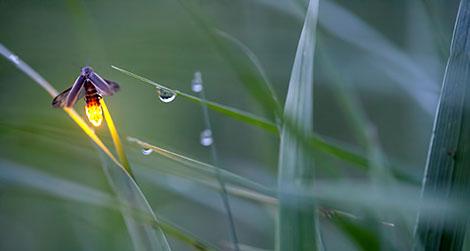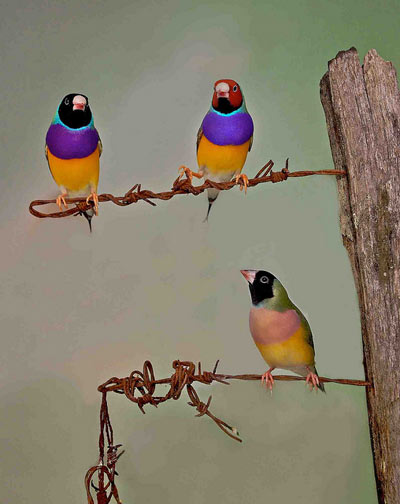And Edy Boardman was rocking the chubby baby to and fro in the pushcar

{ Carli Davidson }
Male seed beetles (Callosobruchus maculatus) have long spikes covering their penises [photo]. These spikes are thought to have evolved in response to female promiscuity, as a way of increasing the male’s chances of fertilizing a female’s eggs. Females, in response to the spikes, have evolved every man’s worst nightmare: spikes inside her vagina.
This is what evolutionary biologists call sexual conflict.
Males and females of a species have a common goal: to pass on their genes to the next generation. Sometimes, however, males and females have conflicting best strategies for getting that done. (…)
The penis of the male seed beetle punctures the female’s reproductive tract and, eventually, all those injuries will kill her. Females even have to kick the male constantly during mating to lessen the severity of the injuries–but she still won’t be deterred from hooking up again.
Why would male beetles want to harm females like this? (…)
While we’re on the topic of sharp penises that harm females, I thought I would throw in a little bed-bug action as well. Bed-bugs mate using what is known as “traumatic insemination.” Males bypass the female genitals entirely and pierce them in a specialized location on their bellies. They then ejaculate into the female sperm storage organ directly.

From amoeba to human, nearly all living things run on an internal clock, a circadian rhythm that regulates our respective business over a 24-hour period. (…)
But what if night stops coming, if daylight lasts all day? Stargazers already are seeing it. The illumination from streetlights and other artificial night lighting is now so persistently bright that 10 percent of the world’s population, and 40 percent of Americans, no longer view a night sky that the human eye perceives as fully dark. It’s a scientific loss for astronomers and a psychic one for the rest of us.
More and more, ecologists are finding that this false light also takes a toll on the natural world. Every year, night-migrating birds collide with bright buildings by the millions. Field studies have shown that artificial light changes the spawning times of certain species of coral and fish whose reproductive cycle depends on a lunar clock. It washes out the mating signals flashed by fireflies. One scientist found that a group of tree frogs halted their mating calls whenever the nearby football stadium held a night game and caused the sky to glow.
photo { Robert Snowden }
Researchers have begun to create a new technology that could soon allow humans and dolphins to talk to each other.
Dolphins have long been considered by scientists to be the most intelligent animals on the planet. But soon, with the help of newly developed underwater translation software, our two species may actually be able to talk to each other.
Armed with a waterproof computer, divers may soon be able to decipher the chirps of dolphins, then create and project an appropriate response, all in real time.
Since the 1960s, captive dolphins have been communicating via pictures and sounds. In the 1990s, Louis Herman of the Kewalo Basin Marine Mammal Laboratory in Honolulu, Hawaii, found that bottlenose dolphins can keep track of over 100 different words. They can also respond appropriately to commands in which the same words appear in a different order, understanding the difference between “bring the surfboard to the man” and “bring the man to the surfboard”, for example.
{ NewScientist | Continue reading | via DigitalTrends }
related { psssst…Imp is a Dolphin! }

Human interactions often provide people with considerable social support, but can pets also fulfill one’s social needs? Although there is correlational evidence that pets may help individuals facing significant life stressors, little is known about the well-being benefits of pets for everyday people.
Study 1 found in a community sample that pet owners fared better on several well-being (e.g., greater self-esteem, more exercise) and individual-difference (e.g., greater conscientiousness, less fearful attachment) measures.
Study 2 assessed a different community sample and found that owners enjoyed better well-being when their pets fulfilled social needs better, and the support that pets provided complemented rather than competed with human sources.
Finally, Study 3 brought pet owners into the laboratory and experimentally demonstrated the ability of pets to stave off negativity caused by social rejection.
In summary, pets can serve as important sources of social support, providing many positive psychological and physical benefits for their owners.
photo { Andre Kertesz, Study of People and Shadows, 1928 | more photos }

The killer whale (Orcinus orca), commonly referred to as the orca, is a toothed whale belonging to the oceanic dolphin family. Killer whales are found in all oceans, from the frigid Arctic and Antarctic regions to tropical seas.
Killer whales are regarded as apex predator, lacking natural predators and preying on even large sharks. [List of apex predators]
Wild killer whales are not considered a threat to humans.
Killer whales distinctively bear a black back, white chest and sides, and a white patch above and behind the eye. Calves are born with a yellowish or orange tint, which fades to white.
Males and females have different patterns of black and white skin in the genital area.
There are three to five types of killer whales that may be distinct enough to be considered different races, subspecies, or possibly even species. The IUCN reported in 2008, “The taxonomy of this genus is clearly in need of review, and it is likely that O. orca will be split into a number of different species or at least subspecies over the next few years.”
• Type A looks like a “typical” killer whale, a large, black and white form with a medium-sized white eye patch, living in open water and feeding mostly on minke whales.
• Type B is smaller than Type A. It has a large white eye patch. Most of the dark parts of its body are medium gray instead of black, although it has a dark gray patch called a “dorsal cape” stretching back from its forehead to just behind its dorsal fin. The white areas are stained slightly yellow. It feeds mostly on seals.
• Type C is the smallest type and lives in larger groups than the others. Its eye patch is distinctively slanted forwards, rather than parallel to the body axis. Like Type B, it is primarily white and medium gray, with a dark gray dorsal cape and yellow-tinged patches. Its only observed prey is the Antarctic Cod.
• Type D was identified based on photographs of a 1955 mass stranding in New Zealand and six at-sea sightings since 2004. Immediately recognizable by its extremely small white eye patch, shorter than usual dorsal fin that curves back, and bulbous head (similar to a pilot whale). Its geographic range appears to be circumglobal in subantarctic waters between latitudes 40°S and 60°S. And although nothing is known about the Type D diet, it is suspected to include fish because groups have been photographed around longline vessels where they reportedly depredate Patagonian toothfish (Dissostichus eleginoides).
Types B and C live close to the ice pack, and diatoms (algae) in these waters may be responsible for the yellowish coloring of both types. Mitochondrial DNA sequences support the theory that these are separate species that have recently diverged.
bonus:
{ On December 24, 2009, a 6,600-pound orca killed trainer Alexis Martínez at a marine park in the Canary Islands. Two months later, trainer Dawn Brancheau was killed by an orca at SeaWorld Orlando. Should Martínez’s death have served as a warning about the lethal potential of killer whales being trained for our entertainment? Tim Zimmermann investigates. | Outside | full story }

{ You may have heard of freshwater sharks, but what about freshwater cetaceans? River dolphins share long thin rostrums, reduced eyes, numerous teeth in both upper and lower jaws, and somewhat flexible necks. | Wild Mammal Blog | full story }
Four nuclear reactors in Japan, Israel and Scotland were forced to shutdown due to infiltration of enormous swarms of jellyfish, which clogged the plant’s cooling system.
Such massive invasions of the jellyfish species have raised speculations and scientists are trying to figure out the reason behind such unusual growing trends.
Recent studies have found out that jellyfish blooming occurs mostly during the summer and spring months. This may partly explain why the three recent power plant incidents happened in close succession. The conditions brought on by climate change may also be creating more jellyfish blooms than there used to be.
{ International Business Times | Thanks Rachel! }
Graham said there have been dozens of cases of jellyfish causing partial or complete shutdowns of coastal power plants in the past few decades, as well as shutdowns of desalination plants. Steve Haddock of the Monterrey Bay Aquarium Research Institute said a power plant in Australia was shut down by jellyfish as long ago as 1937. Such events aren’t surprising; all these plants draw water out of the ocean, and they are already fitted with filtration devices called flumes that remove jellyfish and other debris.
“Only when you have a huge influx of jellies do they overwhelm the flumes,” Graham told Life’s Little Mysteries. This happens when a jellyfish bloom — a huge swarm of adult specimens brought together by ocean currents — flows into a power plant’s filtration system.

{ There are about 2,000 species of fireflies, a type of beetle that lights up its abdomen with a chemical reaction to attract a mate. That glow can be yellow, green or pale-red. In some places the firefly dance is synchronized, with the insects flashing in unison or in waves. The lightshow has also been beneficial to science—researchers have found that the chemical responsible for it, luciferase, is a useful marker in a variety of applications, including genetic engineering and forensics. | Smithsonian magazine | full article }

{ Amy Stein }

{ Wayne Levin }

{ A black-headed female Gouldian finch, Erythrura gouldiae, chooses her mate. Having a genetically incompatible mate can increase a female bird’s stress hormone levels which then can affect the sex ratio of her offspring. | Nature | Continue reading }
related { Effects of stress can be inherited, and here’s how }